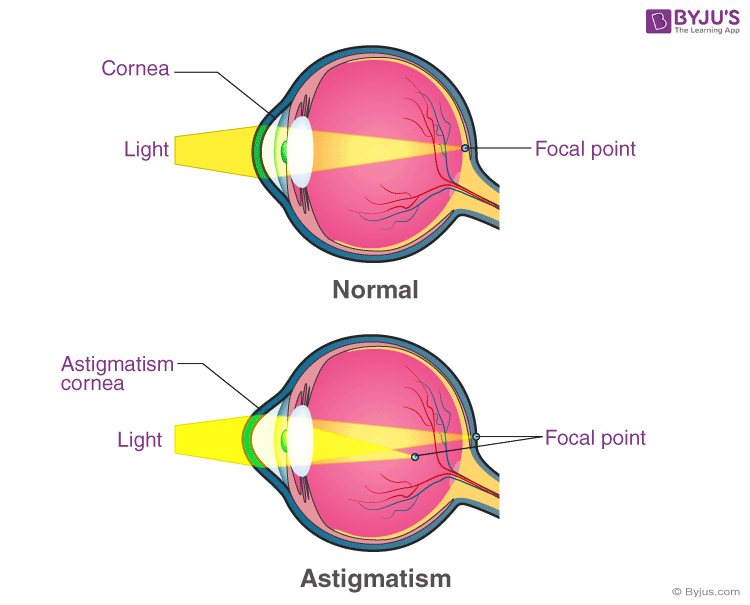Our eyes, the windows to our souls, possess a captivating form that not only grants them a wide-angled view of the world but also offers a compelling insight into human anatomy. The eyeball, the innermost and primary component of the eye, is an intricate sphere that not only houses and protects our delicate visual apparatus but also contributes significantly to our ability to perceive the world around us. However, what, we may ask, are the key factors that underpin the eyeball’s distinctive spherical shape? This article delves into this fascinating feature of the human eye, uncovering the multifaceted forces that work in harmony to maintain the eyeball’s symmetrical structure and enable our clear and undistorted vision.

Image: byjus.com
The Sclera: The Resilient Encasing
The eyeball’s spherical contour is fundamentally attributed to the sclera, a resilient, white, and opaque layer of connective tissue that envelops the majority of the eyeball’s surface. Resembling a fortress, the sclera serves as a sturdy protective shell, safeguarding the delicate inner components from potential impact, mechanical injury, and external pressure. Thick and robust, the sclera comprises intertwined collagen and elastin fibers, imparting both strength and a degree of elasticity to the eyeball. Acting as a natural shield, the sclera preserves the eyeball’s spherical integrity while providing a secure sanctuary for the delicate intraocular structures.
Intraocular Fluid: A Symphony of Inner Pressure
Complementing the sclera’s structural support, intraocular fluid plays a pivotal role in maintaining the eyeball’s spherical shape. Predominantly composed of water, this fluid fills the spaces within the eyeball, including the anterior and posterior chambers. One of its most critical functions lies in maintaining intraocular pressure (IOP). This delicately calibrated pressure acts as a gentle but constant force, pressing against the inner surface of the eyeball. Like a perfectly balanced orchestra, IOP supports the eyeball’s spherical form, ensuring its optimal shape for proper vision.
Muscles and Ligaments: The Balancing Act
The eyeball’s remarkable spherical form is not a static state but rather a dynamic equilibrium maintained by the coordinated interplay of muscles and ligaments. These muscular and ligamentous structures connect the eyeball to the surrounding bony socket, known as the orbit. Six extrinsic muscles, with names that aptly reflect their actions – superior rectus, inferior rectus, medial rectus, lateral rectus, superior oblique, and inferior oblique – can move the eyeball with precision in various directions, allowing us to explore our surroundings. Complementing these muscles, the ligaments provide additional support, preventing excessive movement and ensuring the eyeball remains securely positioned within the orbit.

Image: www.turbosquid.com
Unique Adaptations: Evolution’s Masterpiece
The spherical shape of the human eyeball is not a universal characteristic among species. In the animal kingdom, eyes exhibit a diverse array of shapes and adaptations, each tailored to the unique visual demands of a particular species. For instance, owls, nocturnal hunters with impressive night vision, have characteristically large and cylindrical eyes to maximize light capture in low-light conditions. In contrast, flatfish, marine creatures that spend their lives resting on the ocean floor, possess asymmetrical eyes positioned uniquely on one side of their bodies. These variations highlight the transformative power of evolution, molding the eyeball’s form to suit the specialized needs of its bearer.
What Helps Maintain The Eyeball’S Spherical Shape
https://youtube.com/watch?v=ymJ940_EJ_4
Conclusion: A Spherical Symphony for Unimpeded Vision
The eyeball’s spherical shape serves as a cornerstone of human vision, mediating our ability to navigate our surroundings, interpret the world, and connect with the world around us. Understanding the components that maintain the eyeball’s spherical form deepens our appreciation for the astounding complexity of human anatomy. The sclera, a robust encasing, the balanced pressure of intraocular fluid, the deft coordination of muscles and ligaments – these elements work in concert, conducting a symphony of stability that ensures the eyeball retains its spherical integrity. It’s within this intricate spherical sanctuary that the wonders of sight unfold, a tribute to the marvels of human evolution. As we marvel at the ability of our eyes to transform light into vision, let us not forget the brilliant artistry behind its spherical form, an unsung hero that allows us to see the world in all its radiant glory.